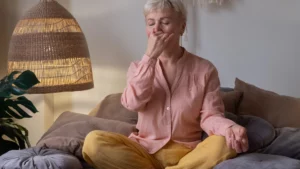Pranayama: Expand Your Life Energy

Breathing is the process of moving air into and out of the lungs to facilitate gas exchange with the internal environment, mostly by bringing in oxygen and flushing out carbon dioxide. Pranayama in yoga is the regulation of the breath through specific techniques and exercises that clear the physical and emotional obstacles in our body to free the breath and so the flow of prana—life energy. Through a regular and sustained practice of pranayama, you can supercharge your whole body!
What follows is a short synopsis of some of the basic pranayama practices. These practices are powerful. Be sure to find an experienced teacher to help you refine your technique.
Mindful Breathing
- Serves as a foundation for practice because breath is always with you
- Can be used as an anchor to the present moment
- Is not a technique; breathe naturally, allowing the breath to be as it is
- Asks that you be mindful of movement or warmth of breath in the nose, chest, abdomen
- Includes deep tummy breathing, which activates the relaxation response
1. Nadi Shodhana Breathing Exercise
It is said in the classical yogic text that nadi shodhana pranayama prepares one to practice other advanced pranayamas. The word nadi shodhana means “to cleanse” or “to purify” the energy channel. This pranayama aims to purify the nadis, or energy channels so that a greater amount of energy flow can occur. It also helps to bring harmony to the entire system.
Simple Nadi Shodhana Technique
 Take a comfortable posture.
Take a comfortable posture.- Inhale and exhale through the left nostril five times by keeping the right nostril closed with your thumb. The rate of breath must be normal, but you must be aware of the breath flowing through your nostril.
- Once you finish the count of 5, release the pressure on the right nostril and then keep the left nostril closed with the ring finger and repeat the same technique.
- Once the five counts are over through the right nostril, release the hold on both the nostrils and breathe in through both the nostrils five times.
- This is one round — practice five rounds.
Alternate nostril breathing is an alternative: Inhale right (while covering left), exhale left (cover right), inhale left (cover right), exhale right (cover left).
2. Rhythmic Breathing Exercise
This is a very simple breathing exercise that can be used in any condition. Here you try to maintain the same duration of inhalation and exhalation. Usually, a person tends to breathe in for a longer duration and breathe out for a shorter duration. If the time of inhalation and exhalation are the same, your breath will harmonize the whole system.
Rhythmic Breathing Technique
- Sit in a comfortable posture. Relax your body until you no longer have to make any further movements.
- Close your eyes and become aware of the bodily posture for a while until your awareness naturally shifts to the breath.
- Observe the breath going in and out without any conscious effort.
- Now you are set to the natural rhythm of the breath. Count the duration of your inhalation. Then match the duration of the exhalation to that of the inhalation. Let the breath flow without any jerks.
- Continue practicing for five minutes.
- Slowly return to normal breathing and end the practice.
3. Ujjayi Breathing Exercise (Psychic Breath)
Ujjayi Pranayama is perhaps the best-known pranayama technique. It calms the entire nervous system and has a soothing effect at the psychic level. In this technique, the glottis is contracted so that there is slight friction when the breath flows through it, producing a light snoring sound.
Simple Ujjayi Breathing Technique 
- Sit in a comfortable posture. Relax your body until you no longer have to make any further movements.
- Close your eyes and become aware of the bodily posture for a while until your awareness naturally shifts to the breath.
- Become aware of the throat and imagine the breath being inhaled and exhaled through the throat.
- Gently contract the glottis. Doing so will produce a light snoring sound (audible only to the practitioner) as you breathe in and out.
- When you practice this technique correctly, there will be a spontaneous contraction of the abdomen. Too much effort should not be put in contracting the throat. It should be gentle throughout the practice.
- Practice for about 5 minutes.
4. Bhramari Breathing Exercise (Humming Bee Breath)
Bhramari means “bee.” In this breathing exercise, the practitioner imitates the humming sound of a bee. This humming sound has a soothing effect on the mind and nervous system.
Basic Bhramari Breathing Technique 
- Sit in a comfortable posture. Relax your body until you no longer have to make any further movements.
- Close your eyes and become aware of the bodily posture for a while until your awareness naturally shifts to the breath.
- Relax your jaw with your mouth closed so that the sound vibrations can be heard.
- Raise the arms sideways and bend the elbows toward the ears. Use the index fingers to close the flaps of the ears.
- Bring your awareness toward the space between the eyebrows.
- Inhale through the nose normally and as you exhale create and become aware of the humming sound reverberate in your entire front skull while you maintain awareness at the center of the eyebrows. The humming sound should be constant throughout the exhalation.
- This is one round, after which you may start again.
- Practice eleven rounds in one sitting.
5. Bhastrika Breathing Exercise (Bellow Breath)
Bhastrika Pranayama requires you to hold onto a steady posture throughout the practice. The posture should be such that it allows easy abdominal movement. This method enables rapid exchange of oxygen and carbon dioxide in the bloodstream, hence producing heat. It also removes wastes and toxins at the cellular level. Some of the benefits of the practice are that it improves the digestive system, blood circulation, and nervous system, and lowers stress.
Simple Bhastrika Breathing Technique 
- Sit in a comfortable posture, keep the head and spine straight.
- Close the eyes, relax your whole body.
- Take deep breaths in out forcefully through the nose. Inhale and exhale with the same amount of force.
- Take note that while you inhale, the diaphragm descends and the abdomen moves outward. During exhalation, the diaphragm moves upward and abdomen inward.
- Practice this for ten breaths. This constitutes one round.
6. Kapalbhati Breathing Exercises (Skull Shining or Frontal Brain Cleansing Breath)
Kapalbhati Pranayama is similar to Bhastrika, but there are some key differences. Bhastrika is the same throughout the whole practice, whereas Kapalbhati breathing exercise becomes slower and longer. Bhastrika uses equal force on both inhalation and exhalation, while Kapalbhati uses forced exhalation only.
Kapalbhati Breathing Technique
- Sit in a comfortable posture, keep the head and spine straight.
- Close the eyes, relax your whole body.
- Exhale with a forceful contraction of abdominal muscles. Let the following inhalation take place automatically while you allow the abdominal muscles to relax. In this method, inhalation is always spontaneous.
- Perform ten such breaths. This constitutes one round.
- Breathe normally before returning to the technique. You may practice five rounds in the beginning.
Reprinted with permission from Jayne Doyle and The Quiet Way.com
 About Jayne Doyle
About Jayne Doyle
Jayne has been in practice for well over 20 years and is specialized in trauma, ancestral trauma, and cancer care, using a range of bodywork, coaching, botanical and vibrational holistic and integrative modalities and teaches yin yoga and yoga nidra meditation. Visit www.thequietway.com for further information and follow The Quiet Way on Facebook and Instagram.
Reference
Prana and Pranayama by Swami Niranjanananda Saraswati



